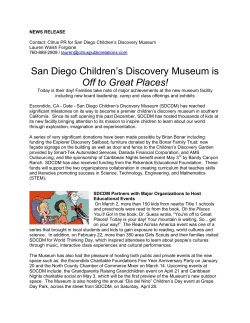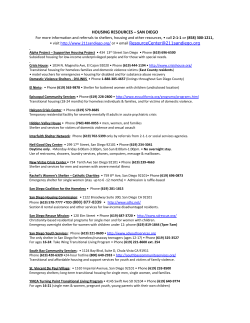
from the International Convention of Exhibition and Fine Art Transporters www.icefat.org
News and Commentary for the Art Logistics Industry from the International Convention of Exhibition and Fine Art Transporters Issue # 3, 2013 www.icefat.org What is Art really worth? IN THIS ISSUE • What is Art really worth? • “M” Museum in Hong Kong • Tech Notes: “Hot dog” Saw • New Member Profile • Antonio Fasani Retires According to some news reports billionaire collector Ronald Perelman was suing Larry Gagosian over a Jeff Koons sculpture of ”Popeye the Sailor Man”. (Popeye is tooting his pipe and holding a can of spinach). Is Popeye worth the 4 million Dollars Perelman paid? Perelman has claimed Gagosian of overcharging for the sculpture and is alleging in his lawsuit the sculpture is worth much less. Other news reports have Gagosian purchasing the Koons back from Perelman and selling it to another collector for much more than 4 million Dollars. In this version Perelman sued because he wanted a share of the profits. No matter which version is true, this beef between two art powerhouses shines some light on art valuations. Who determines what something is really worth and how do they do it? Art dealers charge a percentage to sell a work of art for an artist or a client. At one time the artist got 60% and the dealers got 40%. That has changed over recent years to 50/50, although as values go up and artists become more important, the rates are subject to negotiation. What is important to understand is dealers have incentive to make certain their artist’s prices are always increasing year by year. As long as a dealer controls the market for his artists, most collectors won’t question the real value of their purchases. Auctions are the biggest risk for devaluing an artist's work. Say for example; Joe Smith sells large paintings at a gallery in the two million range. A collector decides to consign his large Smith painting to Christie’s for an auction. If the auctioned Smith is bid for only 1 million, the gallery will have difficulty selling its Smith inventory at the higher prices. This gives the gallery incentive to bid up the painting during the auction to ensure the artist doesn't suffer a price reduction. This is because appraisers, collectors and others use auction sales statistics to determine values. After all, if someone paid four million for a Jeff Koons last year at Sotheby's - it must be worth at least 4 million or more this year - right? 1 From the Chairman September 2013: 2013 Convention edition of ICEFAT News brings you timely and interesting articles from our members worldwide. In this issue of the ICEFAT News we delve into the monetary value in the current art market and a new museum project being considered in Hong Kong, China. As our annual Convention approaches we are pleased to announce that three new companies have passed the grade and will be attending their first ICEFAT Convention in Langkawi, Malaysia. The auction houses are also involved in pushing up art values. They receive sales commissions and expenses based on completed sales and have incentive to maximize returns. To ensure the values stay high, auction houses will set a reserve price. If the art fails to reach that price, it is pulled from a sale. Auctioneers want to work the crowd into a competitive bidding war. One way they accomplish this is acknowledging “phantom” bids. This is known as “chandelier bidding”. The auctioneer pretends to see someone in the audience raising a bid, but is really pointing at a light fixture. This keeps the bidding fast paced and gives the impression of multiple individuals eagerly competing for an artwork, when in reality the bidding had stopped at a lower number. We welcome Transportes FINK, Rio de Janeiro, Brazil, Maurice Ward & Company, Dublin, Ireland and ArtWorks San Diego, San Diego, CA. All of these manipulations of art values mean that collectors, many of whom believe they are sophisticated and smart, are often paying more than they should for the art in their collections. This constant upward pressure on art values buoys the entire art market, resulting in returns on art exceeding those of stocks and bonds during the past 10 years. This “art bull market” has caused the art services industry to prosper and expand. But is it real? Will more collectors like Ronald Perelman feel duped? Will a Jeff Koons Sculpture still be worth 4 million Dollars in 30 years? Will the art bubble burst? As always I am sure you will find this edition of the ICEFAT News interesting and informative. We look forward to the upcoming events – at the end of September our Members will get together in Langkawi for the 37th ICEFAT Convention. Then, about a month later, ICEFAT will be at the inaugural ARCS Conference in Chicago. We will be sponsoring the Welcome Reception and hope to see you there! Bryan Cooke, Cooke’s Crating, Los Angeles M+ Museum: A home for Hong Kong Arts M+ Museum, (Museum Plus) is a Hong Kong’s future museum for visual culture. The museum is scheduled for completion in 2017 and will be at the scale of around 60,000 square meters 580,000 square feet). This is an ambitious project that strives to pursue international presence and exposure – becoming a leading international arts hub and a flagship visual arts venue for Hong Kong. Finally from the Tech Talk corner, The “HOT DOG” Saw. Need I say more to pique your curiosity? Wishing all our readers the very best as the season changes and as a new year quickly approaches. Mark Starling ICEFAT Chair The M+ will be developed in 2 phases with construction scheduled to commence in 2013. The scale of the museum building alone, at around 37,500 square meters, will be comparable with the Museum of Modern Art in New York City. The flagship museum is directly financed by the government with a one-off upfront endowment of $21.6 billion for design and construction. Located at West Kowloon Cultural District, a wedge-shaped waterfront reclaimed land on the edge of the Victoria Harbour, the museum forms a centerpiece at the location. “The Museum is Not the Same as the Building – It is a Relationship Between the Content and its Audiences” - Dr. Lars Nittve, Executive Director M+. “It is not just a building project; it is regarded as a vital tool in bringing together the artwork, artists and the audience” . he ICEFAT News staff strives to continually bring valuable content to this publication. If there is any topic you would like us to report on please do not hesitate to let us know. Ideas and suggestions can be sent to secretariat@icefat.org Focusing on 20th and 21st century visual culture, covering art, design, architecture and moving image, M+ purchased Chinese contemporary art works form Swiss collector Uli Sigg and also received donation of 1,463 works in value of HK$1.33 billion from the collector. The museum’s latest acquisition includes ‘King of Kowloon’ Tsang Tsou-choi’s calligraphy-painted doors. ICEFAT Newsletter Sub-Committee: As the whole project was been suspended between 2010 and 2012, such two-year gap has raised public concerns over the high cost of construction and lack of transparency for failing to keep abreast the public of the progress of development. The project is the first-ever largest cultural project in Hong Kong. There will be a large cultural district to be developed in West Kowloon District and it is believed that a great number of arts administrators will be needed. Demand for training in combination with intellectual and practical skills will be on the rise. It poses a challenge to the city over the needs of arts and cultural manpower as this is a new - yet specific field where professional training for quality cultural management is called for. The project will mark a milestone in Hong Kong’s art and cultural history and we all look forward to its success. May Kwok, BALtrans Hong Kong 2 Bryan Cooke - Editor Stefan Fors Sylvie Fournier-Hausherr May Kwok / Elaine Wong Mike Hascall Jonathan Schwartz Chris Kneale (SC Liaison) Andi Alameda - Design Judith Uijtewaal - ICEFAT Secretary General Tech Notes: The “Hot Dog” SawStop New Member Profile: ICEFAT is pleased to announce three new member companies: Transportes FINK, Rio De Janeiro, Brazil, Maurice Ward & Company, Dublin, Ireland and ArtWorks San Diego, San Diego CA. Transportes FINK and Maurice Ward & Company will be featured in future issues. ArtWorks San Diego How many of you guys (yes, mostly men) have used a table saw in a rushed, unfocused way and had the machine kick the wood back at you… Scary… maybe you lucked out that time. The SawStop website has a timer clock showing when the next table saw accident will occur – less than 9 minutes from right now. SawStop is a table saw designed to stop the spinning blade when it encounters human skin. No way? The pictures of injured SawStop users show fingers with slight pink lines, like a paper cut. This thing works. The website also has interviews with craftsmen who did not have the safety saw. I could not watch all of those. How does it work? The SawStop blade carries a small electrical signal. When skin contacts the blade, the signal changes because the human body is conductive. The change to the signal activates the safety system inside the saw. An aluminum brake unit springs into the spinning blade, stopping it. The blade’s momentum drives it beneath the table, out of harm’s way. The motor is shut off. How long does this take? 5 thousandths of a second. The blade and brake are ruined, but hey, your finger is worth more than the $150 it will take to replace both components. The video that sums it up shows an ordinary hot dog on top of an oak board being pushed through the table saw. The spinning blade cuts the oak until it meets the hot dog. The blade stops hard and disappears beneath the table. The hot dog has a mark the width of the saw blade and maybe 1/64” deep. Maybe less. Those wood workers I interviewed said there can be misfires. Wet wood, pressure treated wood, foil backed insulation. But they all said those are minor learning experiences. They loved the saw! Prices are somewhat higher than similar non-safety table saws. Woodcraft in Seattle had the Contractor Saw starting at $1,600, the Cabinet Saw at $2,300, the Professional Cabinet Saw at $2,730, and the Industrial Cabinet Saw starting at $3,900. But for many of the shops in the Fine Art Handling arena - Museum shops, Professional Crate shops - the “SawStop” table saw is worth a look the next time you have an opportunity. Maybe your insurance agent will thank you -- but there is absolutely no doubt your employees will thank you! The website, SawStop.com, is dramatic! Mike Hascall, ARTECH Seattle 3 ArtWorks San Diego opened for business on January 15, 2007 and currently has 12 employees, most of whom have museum backgrounds and training. The company is located in San Diego, California, which is the 8th largest city in the US, and is strategically located near the Mexico border. The nearby community of Rancho Santa Fe has the 2nd highest per capita income in the USA. Company President, Wendell Eckholm, has 22 years art moving experience, including fifteen years as the General Manager at Cooke’s Crating in Los Angeles. Cynthia Eckholm, Storage Manager and company co-founder, trained as a Registrar at LACMA and the Getty Conservation Institute. General Manager Dustin Gilmore has twelve years of previous art handling experience at the Museum of Contemporary Art, San Diego and San Diego Museum of Art. Wendell Eckholm The AWSD fleet includes three trucks with art delivery services in San Diego, Orange County and Palm Springs, and a weekly shuttle service between San Diego and Los Angeles. Packing, crating and shipping services, both nationally and internationally, originate from an ISPM-15 certified in-house crate shop. ArtWorks can handle installation projects and sculpture rigging– major public clients include City of San Diego, San Diego Central Library, San Diego International Airport, and Salk Institute. The company offers 20,000 sq. ft. of storage in two adjoining warehouses, with wet-pipe sprinklers and Central Station Fire and UL-Certified Burglar alarms. Storage services include climate controlled, air conditioned and general warehouse storage, with over 200 current storage accounts. AWSD is a TSA-approved CCSF facility and recently received recognition as an AXA Art Approved Warehouse, one of only three in California. Museum clients include museums in San Diego County, Orange County and Palm Springs. Other clients include Sotheby’s, Christie’s and Bonham’s auction houses, as well as numerous corporate and private collections. Shipments to Mexico can be coordinated for institutions and private collectors, with door to door ground service to destinations in Tijuana and Baja. Customs clearance, unpacking,installation, and removal of debris can be arranged by AWSD staff. Antonio Fasani Retires Projects in Tijuana include installing the inaugural exhibitions for El Cubo at the Centro Cultural Tijuana (CECUT), a federal government owned institution, and installations at the US Consulate, in Otay Mesa, Tijuana. Exhibitions coming from San Diego museums to CECUT are arranged directly and exclusively through ArtWorks San Diego. Completion of the long-awaited expansion of the international terminals at the San Diego Airport means that wide-body cargo service is now available to and from San Diego directly, rather than having to route shipments via LAX. Current direct international flights include London, Mexico City, Toronto and Tokyo, and direct US service includes New York, Chicago, Miami, Dallas and Boston. WHAT’S ON 2013 ICEFAT Convention Langkawi, Malaysia Sept 26 - 29, 2013 ARCS Convention October 31 - November 3, 2013 Chicago, IL Australasian Registrars Conference March 26 - 29, 2014 Brisbane, Australia Antonio and Maria Luisa Fasani ICEFAT is an organization of art moving professionals. Our associations in working together have blossomed into many friendships between our members. A great friend to all of us is Antonio Fasani of Züst & Bachmeier in Zurich. Antonio has announced his retirement and we will miss him. Antonio Fasani began working in the art shipping department of Züst & Bachmeier in 1992. He became an ICEFAT member that year and attended his first ICEFAT Convention in Santa Monica, California. He was very happy to be able to work in our industry because he loved art and frequently visited museums and exhibitions. Antonio has always been a consummate professional, respected by everyone who had the opportunity to work with him. Antonio and his wife will travel and spend more time in their cottage in Tuscany. He will develop his hobbies: gardening and reading. He also intends to do volunteer work with Caritas, an organization devoted to helping people in difficulty. “Saluti a tutti e arrivederci ….arrivederci” . Ciao Antonio! 9th European Registrars Conference ERC 2014 in Helsinki June 8 - 10, 2014 www.erc2014.fi WWW.ICEFAT.ORG 4
© Copyright 2025









